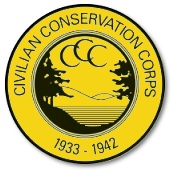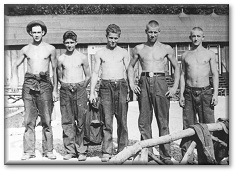Civilian Conservation Corps Museum
Pocahontas State Park, Chesterfield, Va.
". . . Not a panacea for all the unemployment, but an essential step in this emergency . . ." ~ President Franklin Roosevelt
Historic photographs, artifacts and personal mementos are displayed in an original Civilian Conservation Corps (CCC) building outfitted with modern conveniences and equipment to carefully preserve these national treasures. Visitors can learn about the dedication and sacrifice in the words and letters of the men whose contributions will last forever.
By March of 1933, 13.6 million people were unemployed in the United States. In the face of this emergency, President Franklin Delano Roosevelt, only two days after his inauguration,  called a meeting of government officials to create a Civilian Conservation Corps. Roosevelt intended to put 500,000 unemployed youths to work in forests, parks and range lands across the country.
called a meeting of government officials to create a Civilian Conservation Corps. Roosevelt intended to put 500,000 unemployed youths to work in forests, parks and range lands across the country.
During its nine-year run, the CCC employed more than 3 million men and left an undeniable imprint on the nation's landscape. The CCC built more than 40,000 bridges, planted two billion trees, restored nearly 4,000 historic sites and structures, improved thousands of beaches, roads and shorelines, and created 800 state parks across America, including six in Virginia.
On June 15, 1936, just three years after the CCC began, Virginia simultaneously opened six state parks: Douthat, Westmoreland, Hungry Mother, Fairy Stone, Staunton River and Seashore, which is now First Landing. The CCC also helped develop what would become Pocahontas State Park and the National Park Service's Prince William Forest Park.
Our greatest primary task is to put people to work. This is no unsolvable problem if we face it wisely and courageously. It can be accomplished in part by direct recruiting by the Government itself, treating the task as we would treat the emergency of a war, but at the same time, through this employment, accomplishing greatly needed projects to stimulate and reorganize the use of our national resources.
President Franklin Roosevelt, Inaugural Address, March 4, 1933
 Those who served were between the ages of 18 and 25, unmarried and unemployed. They came from families on relief, and $25 of their $30 monthly pay was sent back home to their families. They initially volunteered for six months but could re-enlist for up to a maximum of two years. They joined the CCC as young, Depression-scarred boys, and through their work they left Virginia and the nation a better place.
Those who served were between the ages of 18 and 25, unmarried and unemployed. They came from families on relief, and $25 of their $30 monthly pay was sent back home to their families. They initially volunteered for six months but could re-enlist for up to a maximum of two years. They joined the CCC as young, Depression-scarred boys, and through their work they left Virginia and the nation a better place.
The purpose of the work is both to build men and to build trees.
The Office of Emergency Conservation Work, 1933
You have provided here in Virginia as fine a system of state parks as can be found anywhere.
CCC Director Robert Fechner, June 15, 1936
Just 20 miles from downtown Richmond. From Interstate 95, take State Route 288 north to State Route 10 east, then State Route 655 (Beach Road) west.

Museum hours vary seasonally. Call the park for more information and to arrange group tours, 804-796-4255.
Learn more about the CCC's work in Virginia and elsewhere by visiting www.ccclegacy.org. 











